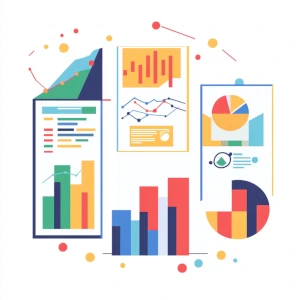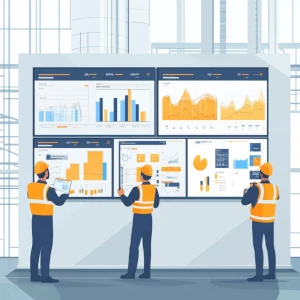7 improvement processes your program management software should support
And how to fix them if they're not working

Introduction
The improvement processes supporting your improvement program should run like a ‘well-oiled machine’ and need to be fully supported by your program management software. Time and attention should be on the actual initiatives you’re trying to implement, not on trying to make these processes work – at least that’s the theory! In practice, what we’ve seen with our own eyes more resembles a junkyard of collapsed processes and outdated systems:
- Spreadsheets groaning to the point of collapse under the weight of trying to keep all improvement information in one ‘single source of truth’ with crippled status reporting
- Multiple systems that don’t quite ‘talk’ to each other e.g., one for collecting ideas and another for tracking initiatives (but only the ‘largest’ initiatives being tracked because it’s ‘too difficult’ to track all initiatives)
- Processes not being used systematically across the organization e.g., Operations doing what’s needed and Finance trying to track what’s happening after the result
In a Continuous Improvement Program or Transformation Program, you may have 100 or a 1000+ initiatives running at different speeds, with widely varying objectives, in different areas of the business across multiple programs at different stages of their life cycle. How do you tie all this together ? How do you manage stage gating, report status or ensure successful completion and delivery of the promised results ?
It’s a common issue faced by all organizations hoping to deliver improvement and it often lands at the door of the Improvement team to fix…
Let’s walk through exactly what processes you actually need, why you need them and how your program management software should support each of these.
Here’s the critical list, based on our improvement experience, of the processes you need when running your improvement program – each of these should be supported by your program management software:
- Organisation wide idea generation/ contribution & prioritization
- Well defined and consistent stage gating process
- Effective implementation planning
- Detailed target setting to drive improvement at pace
- Accurate, timely progress tracking and reporting
- Structured progress reviews driving execution at pace
- Sustained improvement
Let’s run through them one-by-one – essentially in order of program lifecycle starting with generating the initial improvement ideas all the way through to delivering sustainable results.
Organisation wide idea generation/contribution & prioritisation
Does your program management software give everyone the capability to contribute improvement ideas ?
This is often cited as a primary feeling of dissatisfaction in many dissatisfaction – employees feel unable to improve their working conditions or the business – their ideas are not listened or acted on

Common issues include:
- No formal system for idea input or contribution from workforce or potentially a mostly unused ‘suggestion box’ gathering dust
- Ideas, either existing or new are not widely shared or known and idea feedback is always given with the result that the idea contributor is left disillusioned and disengaged
- If ideas are suggested, they are mostly employee grievances and, whilst potentially valid and need acting on, they are not connected to the identified business priorities
What you want and need is an idea contribution system available to everyone and feedback to employees is systematically provided.
Ideas should be seen as a valuable asset – easily searched, shared and replicated across the organization using your program management software.
The Improvement team should be treasuring this stockpile of improvement ideas as a key starting point of any Continuous Improvement or Transformation program and continually utilising the ideas on an on-going basis.
Well defined and consistent stage gating process
Is your stage gating process working well ?
In the early stages of an initiative are you often unclear what the status is or if the initiative has been even been agreed on and who exactly is the owner – and in the later stages of an initiative is it widely known if it has actually been completed or is the initiative in a sort of zombie undead state (i.e., included on reports but no-one working on it) !

Is stage gating well understood across all or most areas of the organization and fully supported by your program management software ? Do you have a consistent, well understood view of what the life cycle is of an initiative (evaluating, planning, implementing, delivering, locked-in) and who exactly is approving the initiative at each gate ? Are the right stakeholders even being consulted.
One result of poor stage gating is that the organization is often working on ideas/initiatives that are low priority. Precious resources are being consumed on private ‘projects’ with no transparency on how many resources are being allocated and what the business benefits will be.
The ideal state is to have initiative stage gating fully supported by your program management software and used by everyone. These gates might vary depending on which stage gating process you’re using. For example, for full transformations you might have gates for each of evaluating, planning, implementing, delivering and locked-in stages; whilst for Continuous Improvement you might have a simpler cut down number of gates. Your program management software needs to fully support all options.
Once you have an agreed stage gating process across the entire organization, then benefits quickly follow:
- The exact status of all initiatives is known at all times and progress reporting can reflect this
- The right stakeholders are consulted prior to each stage
- Resources only work on agreed priorities
You’ll finally heave a sigh of relief at managing to get some control back into your improvement system !
Effective implementation planning
Good implementation planning should set-up each initiative for success; conversely and to use a version of an oft used quote, poor planning results in poor performance with the initiative being late on delivery and not deliver the expected impact..

So what does a poor planning process look like ?
Your program management software needs to fully support all aspects of implementation planning for each of your initiatives. If you recognise any of the following traits in your implementation planning – then you, along with many organizations are, at the poor end of implementation planning…
- Limited time is allocated to the initiative’s implementation plan and the plan is rarely reviewed as part of stage gating process
- The current situation, expected future state and gap is not explicitly defined leaving people unclear on what exactly the initiative will change
- Planning does not define explicit measures of success (process and impact KPIs) – more on these later!
- The work plan consisting of the expected implementation tasks and milestones are not defined or appear to be unrealistic and certainly not with the required detail of What/Who/When
- Major implementation risks and potential mitigating actions are not considered
- It’s unclear who is accountable for delivering success…Is there anyone ‘on the hook’ for delivering ?
Once you have control of the stage gating process, you can then instil the right requirements for a good implementation plan. Essentially, use your program management system to embed an expected list of requirements into a planning stage prior to implementation and make it a condition of passing the gate before implementation that these requirements are in place (i.e., current/future state, expected measures of success, work plan,…).
So, ideally, make sure you have control of your stage gating process before you try to get your implementation planning process working well.
Detailed target setting to drive improvement at pace
Does your organization use targets for your improvement programs ? Are they realistic ? Does your program management software support setting and using targets ? Top-down and bottom-up ?

At the outset of any Continuous Improvement program or Transformation program, you should be thinking about what target you’re trying to achieve. These overall targets need to align with your strategic objectives for the next 1-3 years (a result of your business planning processes).
Ideally the overall target should be broken down into each area of the organization so that each area knows what they are expected to deliver.
These cascaded improvement targets should then be used as a guide (and ‘North star’) to determine if the improvement program is ultimately on track.
All your reports, charts and dashboards should reflect progress against the targets. This will allow everyone reviewing progress to have some context on progress and to understand if progress is ‘good’ (ahead of target) or ‘bad’ (behind target).
To drive improvement pace, these targets should also be time-bound, that is to say that the targets should be phrased in terms of ‘target x needs to be reached by date y’.
Good target setting involves some element of ‘stretch’. In other words, the target is doable but will require significant effort – it’s not a ‘gimme’ by any means.
Lastly, targets should be both top-down at the outset of the program during the diagnostic and bottom-up once the detail of the initiatives is known.
- During the diagnostic, not a lot of detail is known. You’re still determining how you’ll achieve the intended objectives. The target at this stage should closely align with the strategic objectives defined by your organization’s business planning processes. Success during the diagnostic is defining a set of initiatives that will hopefully deliver this top down target
- Once the diagnostic is completed, you have a detailed view of each initiative (assuming you have successfully a embedded good implementation planning process into your stage gating – see above!) A bottom-up target can now be set based on a consolidated view of all initiatives and exactly when they are estimated to start delivering
Your program management software needs to fully support all this functionality to enable you to each apply targets to your improvement programs.
Accurate, timely progress tracking and reporting
If your program management software doesn’t support good stage gating, implementation planning and target setting processes – then you’ll most certainly find progress tracking and reporting a challenging task (and that’s an understatement…).

However, even with stage gating, implementation planning and target setting in place, you may still be hitting challenges:
- Does your organization have a ‘single source of truth’ ? Some organizations have a single spreadsheet – so that would be a yes on this basis – but a big fail on the following two challenges
- Can everyone easily access this reporting in a timely manner ? Is reporting transparent ? Can you split out results by area ?
- Is the reporting visual and simple to understand ? Are progress issues easily identified ? Is it obvious if the initiative or area is behind target either in terms of impact or time ?
Good progress tracking and reporting is considered basic functionality in program management software, but we’ve worked at organizations where progress is simply not tracked at all. It’s treated as an after-thought and implementation ‘looks after itself’. Maybe implementation can look after itself in superbly executing organizations, but we’ve not seen it.
We prefer ‘don’t expect what you don’t inspect’, as the popular saying goes, or otherwise you can expect an unpleasant surprise at the end of the program life. Use your program management software to maintain good transparency and accurate, timely progress tracking and reporting to ensure you deliver without any surprises.
Structured progress reviews driving execution at pace
To drive execution at pace, you need to maintain structured progress reviews at all levels on a regular basis. The more urgency and importance you’re placing on the improvement program and the expected results needed, then the more involvement needed from senior management and the more frequent the reviews need to be.

If you’re not reviewing progress or not doing this in a structured manner or not doing this on a regular basis using program management software, then you’re not providing the guidance needed and your progress reviews are not working with the likely outcomes of:
- Implementation issues not systematically escalated or resolved; no cross-functional support provided…
- …leading to change happening slowly
Additionally, lack of regular progress reviews effectively signals to the organization that the improvement program is low priority compared to all the other work happening. This is just a natural corollary of people working mostly towards their manager’s goals. If the manager is not interested in progress, then it’s likely not a priority and improvement work should be de-prioritised accordingly.
Improvement progress systematically reviewed at all levels/org areas (on schedule and to expected duration)
Progress reviews should be regular, effective and well structured:
- Progress against expected outcomes (targets, plans, impact, KPIs, risks) should be reviewed and deviations understood
- Escalated issues need to be resolved and help provided when requested
And, lastly,
- Priorities/direction should be provided as needed
Ideally, progress reviews should be part of your program management software so that are well structured and effective. Naturally, good reporting and target setting processes need to be in place for the progress reviews to work.
Process to lock-in and sustain improvement
The final gate in the initiative life cycle is to lock-in the delivered improvement. Unfortunately most organizations get this process wrong. The result is that all the hard work in setting up the program, reviewing progress on a regular basis and even delivering initial impact is partially lost as new processes and behaviours slowly lapse. Your program management software can help prevent this.

In any initiative, that involves changes in process or behaviour, you need to ensure that the new processes or behaviours stick.
We’ve worked in an organization, where the initial transformation was a resounding success but returning back to the organization two years later was a sad experience – all the early hard work was lost, the organization had reverted to the ‘old way of doing things’ and performance had declined back close to the original starting point.
What can you do to prevent losing the benefit (and the entire point of the improvement program) ?
Two suggested key sustainability strategies:
- Ensure that your initiative lock-in process is working successfully; You should have a standard checklist that stakeholders consult before approving the initiative for ‘lock-in’. This checklist should be embedded into your program management software and consulted at the ‘lock-in’ gate’. The checklist should include:
- Sustainability steps in the workplan have been successfully completed
- KPI results are consistently as expected for multiple process cycles; ‘Success’ should not be claimed until process and impact KPIs reach target on consistent basis
- Process confirmations are in place to ensure that the new processes and behaviours are working as intended (and if not, understand why not and what needs to change)
- Ensure that process confirmations actually happen post lock-in
So again, you need to make sure your stage gating process is working well to have any chance at successfully implementing these sustainability strategies.
The implementation planning process needs to define the sustainability steps at the outset (before implementation), ensure that the measures of success are defined prior to starting and finally that the plan includes putting in place process confirmations to check on-going processes/behaviours.
Conclusion
In summary, once you have all these processes under control and fully supported by your program management software, your organization should be able to manage and deliver both Continuous Improvement and Transformations like the well-oiled machine it should be – smoothly, efficiently and effectively!
Further steps
As part of building and running an ‘always on’ change capability, the systems and processes are one half of the puzzle. The other half to consider is people and how to build a committed and empowered workforce to make change happen.
See how our Lypta program management software can help you build and manage an ‘always-on’ change capability.
Lastly, all these insights can be downloaded as part of our complete ‘Challenges of Delivering’ pdf.
An 'always-on' change capability guide
The key components needed to enable your Continuous Improvement and Transformation Programs successfully deliver sustainable impact

